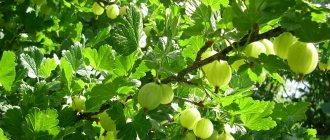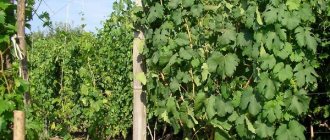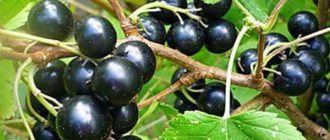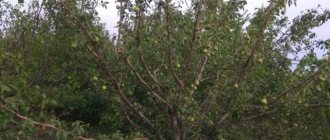Gooseberry Consul was developed not so long ago. Breeders wanted to develop a plant species for breeding in regions with difficult weather conditions. The result of the work was a gooseberry that is not afraid of frost, with tasty fruits and a small number of thorns.
gooseberry variety "Consul"
A feature of the Consul gooseberry fruits is their thin skin and a small number of seeds inside
The “Consul” variety is of particular value to gardeners, characterized by its absence of thorns and high yield.
How did the variety appear?
Consul also has a second title - Senator. This type of fruit plant was developed by V.S. Ilyin is an employee of the South Ural Research Institute. Work on creating this variety began in the 1980s. However, gooseberries were finally added to the register in 1995. True, under his second name, Senator.
Such types of gooseberries as Chelyabinsk green and African were involved in the breeding of the variety. From them the Consul took good tolerance of low temperatures and adverse weather conditions. Such properties allow it to be grown in regions with cold climates.
Characteristics and description of bushes
Medium ripening variety. A bush with a large number of branches reaches a height of 1-1.5 m, a diameter of 2-3 m. Young branches are straight, green, without pubescence. Spikes are absent or small. The shoots are flexible and straight; by the time the fruit is harvested, they bend slightly.
The leaves are small and shiny. They have blunt teeth with distinct veins. Shape in the form of 5 blades of dark or light green color. Petioles with 3-4 leaves and 1 ovary grow on the shoots. Male and female flowers are collected in inflorescences of 2-3 - gooseberries do not require pollination.
Temperature resistance
Tolerance to low temperatures is determined by the cultivation area. In the southern regions, the shrub can withstand frosts down to -25...-30°C. The northern climate is characterized by dry winter air and temperatures of -28...-35°C.
Reference. In regions with cold winters, the shrub needs to be covered with leaves and hay.
Wintering in wet frosts of -25...-35°C leads to diseases, lack of harvest or death of gooseberries.
Moisture and drought resistance
The bush can withstand heat of +30...+35°C, but the fruits dry out or bake in the open sun. The favorable climate for growing thornless gooseberries Senator is moderate.
The variety does not tolerate drought well, so the soil must be kept moderately moist at all times.
Resistance to diseases and pests
The senator is resistant to damage by powdery mildew, but is not protected from attacks by sawflies, root canker, gray mold or septoria and requires preventive measures.
At the beginning of spring, the bushes are sprayed with insecticides and fed with phosphates. Phosphate rock is used as a top dressing at the rate of 2.5–3 tbsp. l./m² or double superphosphate in a dosage of 2–2.5 tbsp. l./m². The most popular insecticides: “Aktellik CE” (10 ml per 10 l of water) or “Bitoxibacillin P” (100 g per 10 l of water).
What does a Consul look like?
The Consul is almost completely spineless. This is a significant reason why gardeners and farmers love it. The smooth trunks of the plant make harvesting more comfortable; in addition, gooseberries are easy to care for without fear of pricking your hands.
Description of the bush
Consul refers to tall bushes, the height of which reaches 1.8 m. The crown is quite dense and spreading. The shape of the gray-brown branches is straight or slightly concave. The foliage is bright green and wrinkled.
The Consul has very few thorns and they are mainly located in the middle part of the shoots. This allows you to significantly save space in your garden. Annual shoots usually have 1-2 spines, but they soon disappear.
Description of berries
Consul gooseberry fruits are usually round in shape and medium in size. The weight of the berries can vary from 2.5 to 6.5 g. Their color is burgundy, which darkens when ripe. There are few seeds inside, the pulp is juicy and transparent, but the skin of the berries is very thin. The taste of gooseberries is pleasant, combining sweetness with sourness.
Productivity and fruiting characteristics
Consul gives a high level of harvest. With proper care, you can harvest up to 20 tons of berries from 1 hectare. One bush can produce up to 3 kg of fruit per season already in the first year after planting, and then increase its yield to 6-8 kg.
In the video below, gooseberries of the “Consul” variety are presented for review:
Gooseberry Consul is a self-pollinating variety. This means that there is no need to additionally plant plants next to it for pollination. Moreover, the lifespan of this fruit plant is over 20 years.
Characteristics and description of fruits
The berries are red or dark pink, round, practically without seeds. Green veins are clearly visible on the surface. The taste is sweet and sour, the aroma is delicate. Tasting score: 4.7 points. The fruits contain 6.7% sugars, 3.1% acids, 25.7 mg% ascorbic acid. The thin skin does not crack when ripe due to its high strength.
The weight of one berry is 3-4 g. Up to 4 kg of crop is harvested from young bushes. As the number of shoots increases, the yield also increases - up to 7-8 kg of berries are harvested from an adult Senator gooseberry per season.
Application area
Senator gooseberries are used in winter preparations. They are prepared from:
- jams;
- jam;
- juices;
- jam.
Gooseberry pulp is well suited for the production of ice cream, desserts, and yoghurts.
Application in cosmetology:
- Hair growth is promoted by rinsing in a decoction of gooseberry leaves;
- to remove age spots, fruit juice and pulp are added to creams and masks;
- Gooseberry seed oil is applied to the hair roots to prevent graying.
Freshly squeezed gooseberry juice normalizes metabolism and strengthens the cardiovascular system. The fruits have restorative and anti-inflammatory properties.
Soil requirements
Plant Consul on loam or sandy loam. Loam is preferable. On such land this variety takes root best. In this case, the soil should be of average moisture.
Do not plant this variety of shrubs in soil that is too wet, heavy or clayey. Also, areas located near water bodies and wetlands are not suitable for cultivation. If there is no other way out, do drainage in the holes.
The optimal soil acidity should not exceed 5.5. Moreover, do not plant the plant where raspberries or currants were previously grown. The soil after them is depleted, and there is a risk of infecting the bush with some diseases common to these berries.
Advantages and disadvantages of gooseberries
Analyzing the characteristics and properties of the Consul, we can highlight its main advantages and existing disadvantages. By the way, not only experienced, but also novice gardeners can grow this variety.
Advantages:
- high harvest;
- absence of a large number of thorns;
- self-pollinating;
- ability to tolerate low temperatures, which makes it possible to grow it in cold regions;
- resistance to pests and diseases;
- long lifespan;
- pleasant taste.
As for the disadvantages, they are:
- poor transportability due to thin peel;
- sensitivity to drafts and winds;
- sensitivity to dry soil.
Time, place and landing pattern
Plant Consul in the period starting from the first half of March, as soon as the last snow melts, or in early autumn, about 30 days before the first low temperatures. Try to plant the plant immediately after purchase, because it is unknown how long the seedling was left without soil.
When choosing seedlings, look at their roots: when cut, there should be a greenish or yellowish core. Moreover, if there are trunks that stand out from the rest with their dark color, do not take such a plant. The branches of seedlings should not break, but be flexible.
Consul gooseberry planting scheme:
- soak the seedlings for a day before planting in a growth-stimulating substance;
- plant gooseberry bushes at a distance of at least 1.5 m;
- dig holes with a diameter and depth of 50-60 cm;
- pour peat or a small amount of humus onto their bottom;
- add fertilizer - 50 g each of potassium salt and superphosphate;
- remove dead shoots on the seedling, if any, and cut the branches by a third;
- When planting a seedling, carefully straighten its roots - while deepening the root collar by 6 cm;
- fill the depression with earth and compact it;
- cover the soil at the roots with straw, sawdust or pine needles;
- Water the planted shrub well with water.
Next, water the Consul, rid the soil of weeds, and remove diseased and dry branches. The planting site must be protected from drafts and well lit, otherwise the berries will ripen unevenly and very slowly.
Features of agricultural technology
Choosing a seedling
In order for the seedlings to take root well and begin to bear fruit without delay, when choosing, you must follow the following recommendations:
- Two-year-old seedlings take root better;
- the seedling must have at least 2-3 shoots more than 20 cm long and 0.8-1 cm in diameter;
- shoots with an open root system should not have mechanical damage, blooming leaves and axillary buds, and the roots should be dark brown;
- gooseberries with a closed root system should be well leafed and sit firmly in the container;
- the roots should not reach the surface of the container and grow through the drainage hole;
Advice! Buy seedlings only from specialized, well-established nurseries or garden centers. When buying from random sellers, the result may be completely unexpected; at best, they will sell you a completely different variety, and at worst: the plant will bring various diseases to your area.
Landing dates
You can plant gooseberries of the “Senator” variety in both autumn and spring. Spring planting, depending on the climate of the region, occurs at the end of March or beginning of April. The guideline is the air temperature, it should be set at around 4-6 degrees Celsius. When planting at this time of year, it is important not to be late and plant the plant while it is dormant. Even a slight delay can lead to the death of the bush. In this regard, it is better to give preference to seedlings with a closed root system; they have a much better chance of taking root in the spring than seedlings sold with open roots.
In autumn, gooseberries are planted 1-1.5 months before the onset of stable cold weather. In most regions, this time falls in the last days of September or the beginning of October. Plants planted on the eve of winter have time to take root and develop a strong root system before the onset of cold weather, and with the arrival of warm spring weather they quickly begin to grow.
Planting scheme
To ensure that shrubs do not compete with each other for nutrients and moisture in the soil, the distance between them is maintained at least one and a half meters. This way the seedlings will have the necessary space to grow and they will not crowd each other. It is important to remember that gooseberry branches grow greatly over the years and therefore they cannot be planted close to a fence or buildings. The best option would be a gap of 1.5-2 meters.
Landing place
When choosing a permanent place of residence for gooseberries of the "Senator" variety, preference should be given to the south or south-east side of the site. The sun-loving shrub grows well and bears fruit in flat areas illuminated by the sun throughout the day. It should be noted that gooseberries do not tolerate places exposed to constant winds. Under such conditions, the harvest becomes scarce, in the worst case, the plant dies altogether.
Boarding order
The place where the bush is supposed to be planted is dug up and at the same time all weeds and their roots are removed. If berry bushes previously grew in this area, then the soil is disinfected with a solution of potassium permanganate. Then the required distance is measured according to the planting diagram and a planting hole is dug, at least half a meter deep. In this case, the top layer of fertile soil is folded into one soil, and the bottom layer into another. The top layer of soil is placed on the bottom of the hole and additionally fertilized with the following substances:
- compost or humus (1 bucket);
- granulated superphosphate (1 matchbox);
- wood ash (liter jar);
Everything is thoroughly mixed and filled with the remaining soil to the level of the middle of the hole. You can begin planting directly in 10-12 days, when the soil settles.
The seedling is placed in the center of the hole slightly at an angle, while carefully straightening the roots. Holding the bush in this position, the hole is gradually covered with earth. Then carefully compact and water generously. The final stage is pruning the shoots. It is recommended to shorten each of them by 4-5 cm.
How to care for gooseberries
To get a rich harvest, it is not enough to plant gooseberries correctly. You still need to properly care for it. This includes monitoring soil moisture, various fertilizing, pruning and staking the bush, proper preparation of the plant for winter, etc.
You can learn how to care for gooseberries in the fall after harvesting from this article.
Humidity and watering
The soil for Consul must be saturated with nutrients and at the same time have optimal humidity for the plant. Systematically water the gooseberries during their development and when they bloom. After watering, loosen the soil.
Don't get carried away with excessive watering. It is enough to do this when the gooseberries bloom, the first fruits appear, and autumn begins. Otherwise, waterlogged soil will lead to the death of the root system of the bush.
Feeding
The plant needs to be fed the following year after planting:
- at the beginning of the spring months, apply nitrogen fertilizers for the active growth of branches and leaves - 12-15 g of water and saltpeter diluted in 10 liters will be needed per bush (feed in 2 stages, with a difference of 7-12 days);
- in the summer, before flowering begins, add 70-80 g of potassium chloride and superphosphate - these substances can be replaced with 0.3-0.4 kg of wood ash;
- After harvesting, also feed the gooseberries with manure or humus - approximately 5 kg per plant.
How to trim and shape bushes?
Before the buds bloom, the gooseberries need to be trimmed, forming its crown:
- remove all diseased and dried branches;
- For young shrubs, leave only large and well-developed trunks;
- After trimming the foliage, loosen the soil under the gooseberry itself.
Garter and support
Gooseberry branches need a garter and support - wooden pegs with a mesh. It is necessary to tie up the bush to prevent branches with gooseberries from falling to the ground, which can lead to damage to the crop. In addition, it is easier to pick berries from tied bushes.
How to tie gooseberries:
- carefully drive the stakes with the mesh into the ground, being careful not to damage the roots of the plant;
- tie large branches with berries to the structure;
- You don’t need a lot of supports, since the Consul’s branches grow upward.
Preparing for winter
The amount of harvest depends on how well the plant survived the winter. Since the Consul is not afraid of frost, it is not necessary to cover it. This should only be done if there is not too much snow in the region.
What else needs to be done before winter arrives:
- trim the branches of the bush;
- spray gooseberries against pests;
- remove and burn accumulated debris and fallen leaves;
- Feed the plant with the necessary fertilizers.
Growing and care
In order for the Consul gooseberry to produce a stable harvest and high-quality berries, it needs to be regularly watered, loosened, mulched, and fertilized. Every month, plantings should be treated against beetles and diseases with insecticides or fungicides.
Watering
Gooseberry Consul should be watered once every 14 days. The variety is susceptible to excessive moisture, which can lead to rotting of the root system. Irrigation should be carried out during pollen and berry ripening. The last watering is carried out 2 weeks before harvesting the fruits. Apply moisture from a hose or watering can with the sprayer removed so that water does not get on the leaves. They may get sunburn. The optimal liquid consumption when watering is 5 liters for each bush. Pour in settled water; if you use cold moisture, the leaves will fall off.
Top dressing
Gooseberries of the Consul variety are fed to increase productivity and improve the taste of the berries. Feeding is applied 3 times during the growing season according to the scheme below.
- During the appearance of the first leaves. Prepare a solution from 1 tablespoon of urea, 2 tbsp. nitrophoska, 10 liters of water. 15 liters of nutrient liquid are poured under one bush.
- During flowering. Make a solution from 1 tbsp. potassium sulfate, 2 tbsp. complex fertilizing for berry crops per 10 liters of water. 25 liters of the combination are poured under 1 plant in 3 approaches, combining fertilizers with irrigation.
- During the formation of ovaries. You will need 1 tbsp. nitrophoska, 2 tbsp. potassium humate. They are dissolved in 10 liters of water. Each bush requires 30 liters of solution, apply it in 4 approaches, combining with irrigation.
In the absence of fertilizers, productivity and plant immunity decrease.
Trimming
Gooseberry Consul needs to form a bush. When planting, the bush is cut off to 1/3 of its length. Remove dry, diseased branches. In the future, pruning is carried out in order to prevent pathologies and excessive growth. The branches should not thicken or block ultraviolet rays. In the absence of sun heating, the taste of the berries suffers. After pruning, the soil is loosened to the floor with a shovel, without touching the rhizomes.
Loosening
Gooseberries prefer loose, aerated soil. The soil around the bushes is plowed to a depth of 15 cm, with an interval of 3 weeks. Experienced gardeners recommend combining loosening with the addition of a mulch layer. Mulch prevents the soil from drying out, inhibits the growth of wheatgrass, protects the bushes from overheating, and acts as a source of nutritional components. Straw, leaves, sawdust, and rotted manure are used as a mulch layer.
Preparing for winter
The Consul variety of gooseberries survives winters safely; you can do without shelter. At the end of October, a number of manipulations are carried out that will help the bushes successfully withstand frost and bear fruit abundantly in the next season. Preparatory activities include:
- sanitary pruning;
- spraying shrubs with insecticides against harmful insects;
- cleaning, burning garbage, fallen leaves.
At the end of October, humus, compost, and peat are added as fertilizer.
How to propagate the variety?
Consul can be propagated in two ways:
- Using cuttings. Cut the plant from July to autumn, cutting off an oblique part of the branch about 15 cm long. The cut cuttings must have at least a couple of buds. Then treat the cuttings with substances that enhance the growth of the root system, and place the shoots at an angle of 45 degrees in loosened soil so that 2-3 buds remain above the ground. Next, simply water the plant.
- By layering. In this case, bend the annual shoots to the ground, and then secure them with a metal bracket and sprinkle with soil. Systematically water the shoots, and when young branches appear on them, separate the seedling from the mother plant.
Dates and step-by-step instructions for disembarkation
Gooseberries of the Senator variety are planted in autumn or spring. In order for the bush to take root, you need to follow the scheme:
- Before planting, soak the sprout for a couple of hours in a growth stimulator (sold in specialized stores).
- Dig a shallow hole 35-50 cm deep.
- Put humus on the bottom.
- Fertilize with 45 grams of potassium salt.
- Leave the hole to soak in fertilizer for a day.
- Before planting, remove dried branches from the plant.
- Place the seedling into the prepared hole at a right angle, cover it with soil, and pour plenty of water (about 5 liters).
See also
When and how to pick gooseberries correctly so as not to inject yourselfRead
After planting the gooseberries, you need to trim the shoots a little (by 3-5 cm).
Protection from diseases and pests
Despite the Consul's resistance to some diseases typical of gooseberries, it also needs protection. This plant is vulnerable to columnar rust and anthracnose. Gooseberries are also sometimes attacked by moths, gooseberry aphids and spider mites.
How to deal with this:
- Columnar rust and anthracnose . Cuprozan or a 1% solution of Bordeaux mixture will help get rid of diseases. Spray gooseberries with substances before flowering and after harvesting the fruits.
- Moth and gooseberry aphid. Such drugs as Karbofos (dissolve 60 g in 10 liters of water) or Inta-vir (dissolve 1-2 tablets in 10 liters of water) will help fight pests.
- Spider mite. You can get rid of it with the help of Actellik (dilute 2 ml of the drug per 2 liters of liquid). The drug will also help get rid of aphids and moths. Please note that Actellik is toxic to organisms living in water. Therefore, if there are bodies of water nearby, it is better to choose another drug.
Do not forget to regularly inspect the bushes and remove damaged or diseased branches, and also monitor the absence of insect colonies on the gooseberries. Dig up the soil in the fall and loosen it in the summer, rake and burn falling leaves - this will help in pest control.
Reviews from summer residents
Gardeners are happy to share their experiences, achievements and failures in growing this variety.
Natalya, St. Petersburg: “I purchased a Senator seedling from O’Key.” At the same time I took another variety, with thorns. I planted it in open ground at the end of April. Arriving at the dacha a week later, I noticed that the Senator was frail and lethargic and was not settling in well. I watered the plant, fed it, treated it for pests - it seemed to help. The bush took root and began to grow. Despite the unpretentiousness of the variety, it was not possible to grow it by planting alone. The culture definitely requires attention and care.”
Elena, Samara : “I like the Senator gooseberry because of the taste of the fruit - the berries are much sweeter than other varieties. The plant safely survives winter with severe frosts. The children fell in love with this bush because it has no thorns.”
Use of berries
Thanks to its rich composition and pleasant taste, this gooseberry can be used in:
- culinary sphere - for preparing sweets, as a filling for various pastries and desserts;
- cosmetology – gooseberry juice helps to whiten the face, reduce pigmentation, and moisturize the skin;
- folk medicine - consumption of gooseberries is recommended for liver and kidney diseases, as a sedative.
Reviews of gooseberry Consul (Senator)
★★★★★
Igor, 45 years old, Kirov, builder. I would like to note that this gooseberry is very easy to care for.
You don’t need to do anything special with it - just water it and trim the bush on time. The good news is that the variety is resistant to diseases - during the entire time it has been growing, it has never been sick with anything. ★★★★★
Alexandra, 32 years old, Belovo, accountant. A very good harvest comes from the bushes.
I like that there are few thorns. You pick gooseberries and don’t feel any discomfort. Easy to care for - I did not cover it in winter and this did not affect the yield of the variety. Hide
Add your review
Consul is in good demand among summer residents and gardeners due to its good yield, resistance to frost and ease of care. Proper growing technology and proper care will make it possible to enjoy the fruits of this gooseberry for many years.
0
0
Copy link
About the pros and cons
gooseberry Consul
Let’s immediately determine the advantages and disadvantages of this variety.
Gooseberry Consul, as we have already noted, is quite unpretentious, and bears fruit more than actively. It is grown with pleasure in the Far East and Siberia. The fact is that the plant is very resistant to temperature changes. However, you should become familiar with both the advantages and disadvantages of the variety.
When determining the advantages , it is important to say that gooseberries are frost-resistant, thorns practically do not form, and the harvest is plentiful. Gooseberry Consul is self-pollinating and bears fruit for decades. But it is practically not affected by diseases.
Of the minuses , the following should be noted: gooseberries cannot be transported over long distances, the plants are afraid of drafts, and are also susceptible to drought. Consul needs to be watered frequently. Since overdrying the soil negatively affects the development of gooseberries.
It should also be noted that its fruits contain a lot of vitamins and microelements, especially vitamin C.











